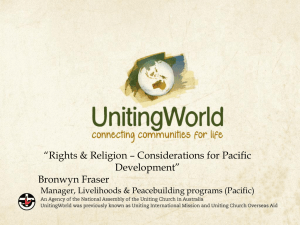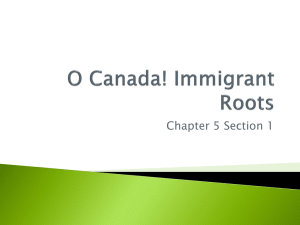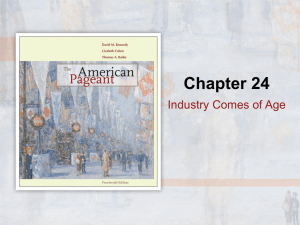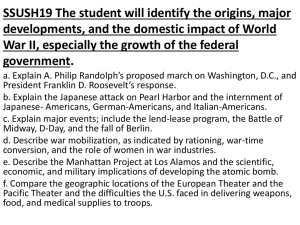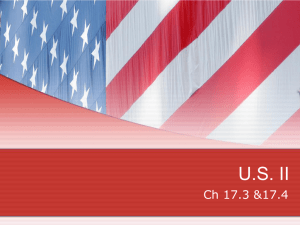The Pacific: Then and Now
advertisement
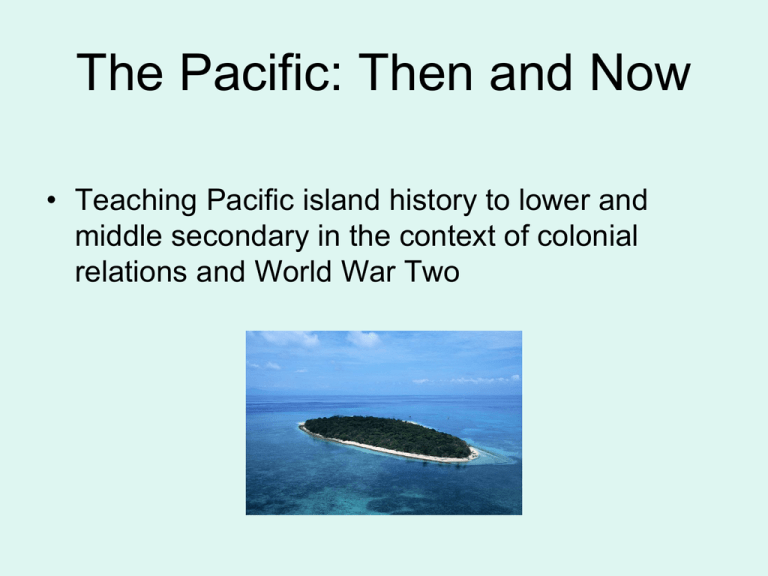
The Pacific: Then and Now • Teaching Pacific island history to lower and middle secondary in the context of colonial relations and World War Two Aim and Structure of Presentation • To discover the knowledge that we may already have or think we have about the Pacific region. • To trace the origin of some of those culturally located understandings and consider how they inflected historical events and continue to impact thinking and political behaviour • To reiterate the importance of teaching students in Australian schools about the Pacific region and their place as local and global citizens • To propose some strategies with regard to teaching and introduce the Pacific Neighbours resource. What we think we know • Western knowledge of the Pacific region is heavily weighted with escapist fantasies about deserted beaches and idyllic holidays. • There is a long and complex history attached to the development of these understandings Starter Activity • Shut your eyes and think of the Pacific island region. • Write down the colour, the symbol and the image that come to mind when you hear the words “Pacific Island”. Imagining the Pacific • Write down three things you know about one or more Pacific islands. • These could include history, geography, culture, weather, lifestyle or other factors and be acquired through reading, travel or other experiences. Some Pacific Facts The Pacific Ocean covers about 1/3 of the earth’s surface. There are more than 25,000 islands and islets (or atolls) of 25 nations and territories spread over the Pacific. Its total population is about 30 million people. Pacific islands are the home of some of the most remote and economically challenged nations on earth. Australia in the Pacific Since WW2 it has become a political and economic mantra that Australia is “part of Asia”. However, geographically and historically, it is equally important to understand Australia as a Pacific island continent. The rationale of Pacific Neighbors is that developing an understanding of our region and our closest neighbours is fundamental to fulfilling our role as responsible global citizens. Pacific Neighbors is informed by ACARA, The Melbourne Declaration on Educational Goals for Young Australians (2008) and A Framework for Global Education in Australian Schools (2008) Learning focus: Pacific stories and human rights Key Concepts • Early exploration and colonial relations • World War 2 in the Pacific • Nuclear testing in the Pacific • Year Levels • Years 7 & 8 • Years 9 & 10 • Years 9 &10 Colonial History • The Pacific Islands were among the last regions to be discovered and mapped by European seafarers and explorers. • While late to be claimed as colonial possessions they were equally late to gain independence. • Small (in global terms) economies, isolation and limited natural resources means that in many cases, independence has been nominal: “more a political process than an economic or cultural one” (During, 1992). Early Pacific Contact • • • • • • • • • A variety of evidence (linguistic, genetic and archaeological) suggests that Melanesian islands were occupied by Papuan people from about 50,000 years ago and that significant migration from Asia through the Pacific to Polynesia began around 6,000 years ago and continued for several thousands of years until New Zealand was finally settled by Maori people about 1,000 years ago. Over time these early settlers developed large, double hulled vessels capable of traversing great distances and carrying groups of people as well as their plant and animal stock. 1519 Ferdinand Magellan sailed from Portugal through the straits of Magellan to the Philippines, making contact on Guam and the Marianas. 1526 Alonso de Salazar recorded sighting the Marshall islands. Francis Drake sailed across the Pacific but did not have contact with Pacific islanders. 1634-43 Abel Tasman visited Tasmania, New Zealand, Fiji and Tonga. 1767 Samuel Wallis landed in Tahiti. 1766-69 Louis de Bougainville made contact in Tahiti, Samoa, Vanuatu and the Solomons. The reports of Wallis and Bougainville popularised in England and France the idea of an earthly paradise in the South Seas. 1768- 79 span the years of the three Cook voyages. Cook mapped Tahiti, New Zealand and the east coast of Australia, landed at Easter Island, New Caledonia and Vanuatu and mapped Hawaii. Pacific Mappings • The divisions between Polynesia, Melanesian and Micronesia date back to the Gook voyages and although in common use are challenged by many island people. Those who most object to the terms prefer to use the terminology “Oceania”. • Established on racial as well as geographic categorisations, the names can be seen to be part of the C19 project of classification and cartography. The Romance of the Islands • In 1777, John Webber (artist accompanying the 3rd Cook voyage) painted Poedooa in the traditions of C18th classicist beauty. • This built upon earlier descriptions of islander women. In 1768 Bougainville had written that a young Tahitian girl appeared as “Venus…with the celestial form of that goddess” • These images and writings are the fore-runners of a prevailing Western romance with the “hula girl” and the idealised Pacific island. Colonising the Pacific • A beginning activity for students working with this material might be the mapping of a time line. This could include some dates related to the indigenous settlement of the islands followed by European contact dates and colonial claiming. It might also go on to chart dates of national independence and lead to discussions/debates about what “independence” actually means for aid dependent nations. • An example of an excellent interactive time line can be found at http://www.timetoast.com/timelines/58432 Thinking about our thinking about the Pacific • In the context of mapping colonial history and engaging with the past and present infringements of the rights of Pacific islanders it is valuable to consider the evolution of the types of thinking that supported activities such as colonial appropriation and indentured labour. • There are particular ways in which Western cultures have tended to view the Pacific region and these have remained remarkably constant through time. These include the fable of the “deserted island” and the “treasure island”. Where have these myths come from and do they still have meaning? Treasure islands • • In 19th and 20th century film and fiction there is a recurring Pacific island genre. The first is about solace and tropical peace – escaping from the pressure of modern life. This is ubiquitous and has been commercially appropriated in marketing for Pacific island holidays. Another is the “treasure island” usually buried pirate treasure. This seems to be an antidote to the fact that Pacific islands were never great generators of income for their colonial masters. Bar the phosphate industry, the C20th importance of Pacific islands came to be specifically about military/political strategy. The Blackbird Economy • The economic benefit of the latter C19th relationship between Australia and its Pacific island neighbours was primarily located in the industry of “black-birding”. With the cessation of convict transportation and expansion of agrarian enterprise, large numbers of cheap manual workers were in demand. Between 1863 and 1904 about 55 000 Pacific islanders were black-birded to Australia. Some were abducted and treated as slaves, others (usually later) came voluntarily under contract as indentured laborers and later returned to their own homes relatively economically better off after being paid 6 pounds a year. They worked mostly in Queensland in the farming, mining and pearling industries. Questions for students • Compare the different stories of islanders recruited to work in Australia • How were they treated? • Should the workers have been allowed to stay if they wanted to? • Why were they forced to go home? World War 2 in the Pacific • The Pacific war provided an opportunity for many Australian servicemen to acquire an understanding of the Pacific region and their own part in it as distinct from Australia being a British colony Islands as a war zone • The war also visited violence upon Pacific islanders and their homes. Many suffered simply from being resident in a war zone. Others were injured or punished (sometimes tortured or killed) for supporting opposing sides. • In Micronesia local people tended to support the Japanese and were penalised for this at the end of the war. In Polynesia and Melanesia, local support generally turned towards the Allies. Suggested student activities • Consider the traditional life of a village in Papua New Guinea before the war • Discuss the impact that war would have on village people, considering such factors as cultural contact and change, food supply (farming and fishing), violence, environmental damage and direct involvement in the war. • In small groups take on the role of a Papua New Guinean family/village and talk about how you might be compensated for the damage done to your people and environment by the war. Write a letter explaining your need for compensation to the Australian government. Soldiers and Hula Belles • Allied soldiers arrived in the Pacific with expectations fed by Hollywood movies about island paradises and hidden treasure but mostly about the “hula girl” – the beautiful woman who welcomes travellers to the island and enhances their stay. Many Pacific historians have argued that this sort of representation distracts from the violence of colonial contact and war. This particular myth has a long history and intersects with war and nuclear colonialism. Look at this cartoon. Take a moment. What do you see? What do you think? What do you wonder? Racism and Sexism in the Pacific • The idea of the hula girl clashed with the reality of the Pacific war experience. • As well as dealing with their war ravaged home environment – villages were bombed and destroyed, fishing habitats unsafe and contaminated, farms damaged and family members killed, or involved in the war – islanders contended with racist assumptions which sometimes overflowed into violence. Islanders were not always treated well by Allied servicemen. Suggested student activities • Imagine yourself an Australian soldier stationed in somewhere in the South Pacific during WW2. Identify your location. • Write a series of journal entries describing what you see and how it differs from what you expected. Describe local conditions and the local people you meet. Reflect upon what they must be thinking of you and the war. The Bikini • In 1946, French fashion designer Louis Reardon showed a new and daring version of the two piece swimsuit, cut deliberately to draw attention to the same parts of a woman’s body that it was designed to conceal. He named it the bikini to celebrate the nuclear tests that had just been carried out in the Marshall Islands. • A sexy bathing suit designed for pristine beaches had been given a name synonymous with military imperialism and nuclear contamination. Post war Nuclear testing in the Pacific • The American, French and British governments in total carried out about 240 nuclear tests in the Pacific between 1946 and 1996 • The people most impacted were the 167 Bikinians who were displaced so that 67 tests could be undertaken on Bikini Atoll between 1946 and 1958. Moved to different unsuitable sites they pined and starved. They were eventually allowed to return to their home but forced to move again several years later when it became apparent that the atoll was irredeemably contaminated. Student Activities • Discuss the reasons why nuclear testing originally seemed like a good idea. • Review the arguments which were presented to the Bikinians to persuade them to leave their island. • Use the (simplified version) of the Universal Declaration of Human Rights as a framework to consider the infringement of human rights. cyberschoolbus/humanrights/resources/plain.asp • Have a class debate with one side arguing the US case for “the good of mankind” and that the Bikinians have been adequately compensated, while the other side arguing the Bikinians case that nothing can ever fully compensate you for the loss of your homeland and culture Pacific Neighbours • Overview and Photo Gallery • Review the Pacific Neighbours resource Resources • cyberschoolbus/humanrights/resources/pl ain.asp • http://www.timetoast.com/timelines/58432 • http://digicoll.manoa.hawaii.edu/hwrd/Pag es/about.php?s=about • http://whc.unesco.org/en/list/1339/

